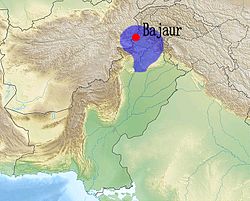Apracharajas | |
|---|---|
| 52 BCE–78 CE | |
Silver coin of the Apracaraja Vijayamitra
| |
 Approximate location of the Apracharajas. | |
| Capital | Bajaur |
| Common languages | Gandhari Prakrit |
| Religion | Buddhism |
| Government | Monarchy |
| Raja | |
• c. 52 BCE | Vijayakamitra |
• c. late 1st BCE | Visnuvarma |
• c. 2 BCE | Vijayamitra |
• c. 32 CE | Indravasu |
• c. 50 CE | Indravarma II |
| Historical era | Antiquity |
• Established | 52 BCE |
• Disestablished | 78 CE |
The Apracharajas (Gandhari: 𐨀𐨤𐨿𐨪𐨕𐨪𐨗),[1] also known as Avacarajas (Gandhari: 𐨀𐨬𐨕𐨪𐨗),[2] were a local ruling dynasty of Gandhara. The Apracharaja capital, known as Apracapura (also Avacapura), was located in Bajaur,[2] though from numismatic evidence and reliquary inscriptions, it is asserted that their territory encompassed the wider region of Gandhara, including the cities of Taxila and Pushkalavati.[3] Under the administration of Sases, their domain expanded to incorporate the former territory of the kingdom of Porus, which extended as far as the river Ravi in the Punjab.
Based on analysis of their inscriptions and coinage, the Apracharajas are widely believed to have served as significant benefactors of Buddhism. Translated inscriptions indicate the donation of stupas and reliquaries in honor of the Buddha. Notably, Indragivarma, the second son of Vijayamitra the Apracharaja, and Utara, the spouse of Indravarma, detail the construction of stupas in previously unestablished locales. These inscriptions and coinage are consistently composed in Gandhari Prakrit, utilizing the Kharosthi script, thereby highlighting the adherence of these rulers to Gandharan culture.
The genesis of the Apracharajas is traced to the Apracharajas Visnuvarma and Vijayamitra, however the Bajaur casket inscription associated with them suggests a predecessor named Vijayakamitra, stated to have flourished during the era of Menander II of the Indo-Greek Kingdom. Research on reliquary inscriptions also further describes that Vijayamitra's direct predecessor to have been a Visnuvarma, however he has not been accurately dated.[4] Notably, the administrative structure of the Apracha polity is characterized by a hierarchical arrangement, wherein absolute power is held by the patriarch (Apracharaja), followed by subordinate generals, denoted by the Greek term "Stratega" in inscriptions. Of particular interest is the case of Satruleka, an Apracha figure who is bestowed with the title Satrap, deviating from the typical hierarchical designations. Below these tiers were Apracha princes who were potential successors to the throne.[5]
- ^ Richard Salomon, The "Avaca" Inscription and the Origin of the Vikrama Era, Journal of the American Oriental Society Vol. 102, No. 1 (Jan. - Mar., 1982), pp. 59–68.
- ^ a b Richard Salomon, An Inscribed Silver Buddhist Reliquary of the Time of King Kharaosta and Prince Indravarman, Journal of the American Oriental Society, Vol. 116, No. 3 (Jul. - Sep., 1996), pp. 418–452
- ^ Cite error: The named reference
:1was invoked but never defined (see the help page). - ^ "Buddhism and Society in the Indic North and Northwest, 2nd Century BCE–3rd Century CE" (PDF).
Loṇa identifies herself as a woman of the inner court, a minor wife of Viṣ̄uvarma, who is here entitled prince. His status as prince indicates that he is eligible to succeed the current Apracarāja ruler, who is neither named here nor elsewhere.... All that can be concluded is that the Apraca dynasty predates all evidence we have for it, sometime in the early to mid 1st century BCE.... The presence of two Apracarājas, Viṣ̄uvarma and Vijayamitra, in this inscription previously presented issues to scholars as they are named without explicit reference as to who was the current or the former... Harry Falk argues that in the Indic Northwest the title was more restricted in its usage, denoting a widowed wife of a deceased ruler who is mother to a present ruler. This is true in the case of Uzaṃda, the still living (tiṣṭhatā) mother of the Oḍirāja Seṇavarma, as it is made explicit that the latter's father, Ajidaseṇa, is deceased. Applying this logic to the case of Rukhuṇa, Falk thus argues that her husband Viṣ̄uvarma is deceased and that Vijayamitra is the living son to whom the title refers and the current ruler. (ruling out the situation in which they reigned concurrently)
- ^ "Buddhism and Society in the Indic North and Northwest, 2nd Century BCE–3rd Century CE" (PDF). p. 177.
The Apracarājas thus installed their own political system, which was structured in terms of a dynastic hierarchy. At the head were the patriarchs, the rulers who were ubiquitously entitled Apracarāja. Six have been hitherto identified—Vijayamitra I, Viṣ̄uvarma, Vijayamitra II, Indravasu, Vijayamitra III, and Indravarma—although the existence of the three Vijayamitras remains unclear, as does the identity of Indravarma. Underneath them were the Generals, of which four are named—Vaga, Indravarma I (who may have become Apracarāja), Viśpavarma, and Aśpavarma—but their positions in the dynastic lineage are again uncertain in many cases. Finally, several figures are called prince (kumāra)—Viṣ̄uvarma, Indravarma I, Indragivarma, and Indravarma II—of whom at least one was to become a general and two were to become rulers, indicating the status was reserved for potential successors.
